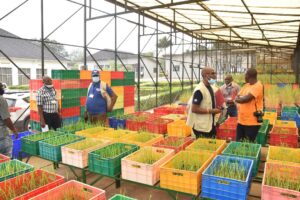by Paul Hilario
One important insight that I would like to share is that rice-themed paintings usually display positive messages. The rice fields signify abundance, blessings, serenity, happiness, and hope. Rice farmers represent family, perseverance, teamwork, camaraderie, and patience. There are many more things it symbolizes depending on the viewer. On the other hand, rice farming also signifies poverty and back-breaking work. Many rice farmers and laborers are dirt poor. It is ironic.
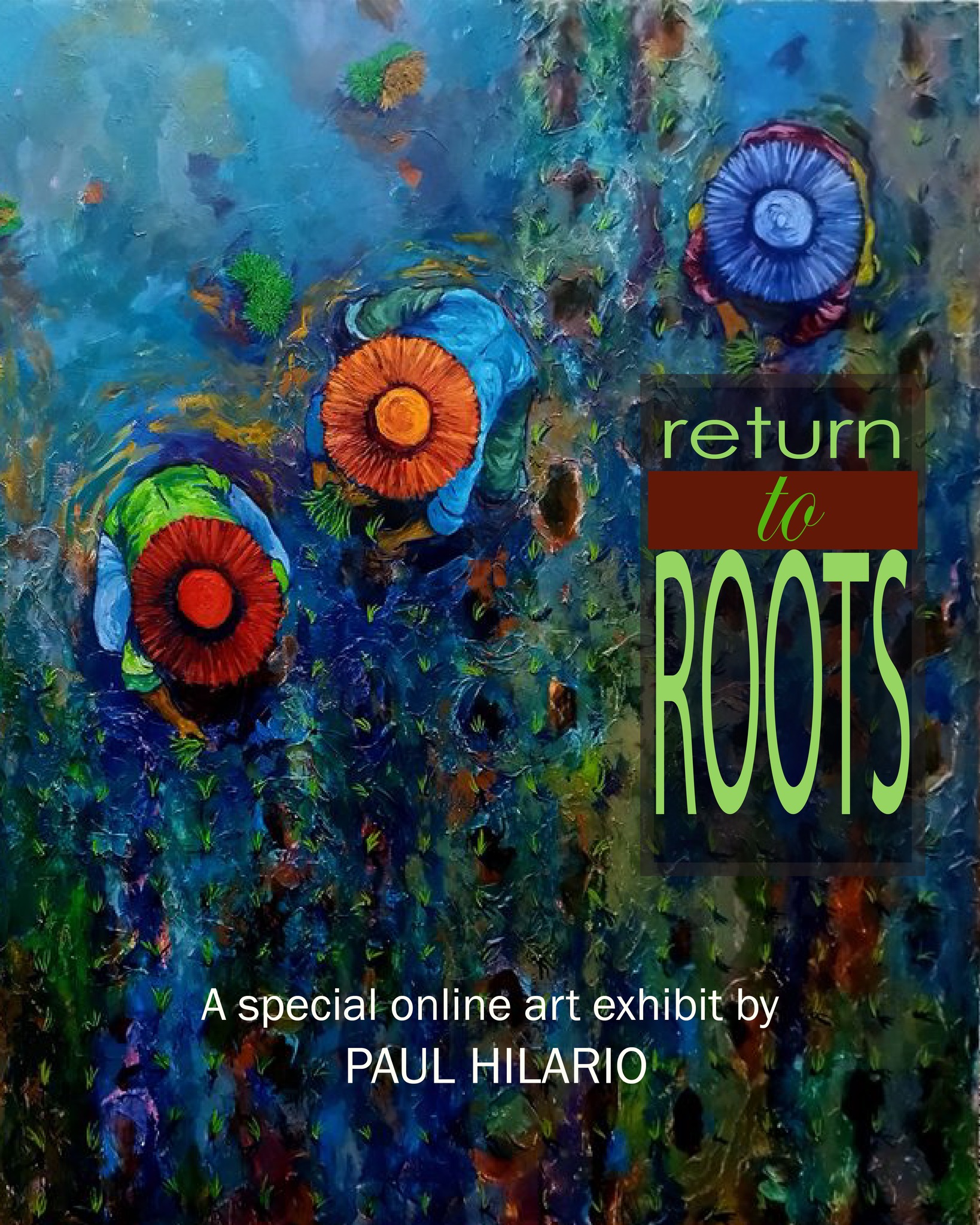
My creative love affair with rice started when I picked up a paintbrush again in December 2010. I said “again” because I did draw and paint a lot when I was much younger. But that is another story.
I started working at the International Rice Research Institute (IRRI) in 2003 as the curator for the Riceworld Museum and Learning Center. Riceworld was the first museum in the world dedicated to rice and one of only two rice museums in the Philippines. The other one is the Rice Science Museum at the Philippine Rice Research Institute in Munoz, Nueva Ecija.
Aside from managing the Riceworld’s day-to-day activities, I mostly designed and set up rice science exhibits not only in different locations in the Philippines but also in other countries that invited IRRI. I also curated IRRI’s art collection. Working at IRRI, I met and talked to many rice researchers, scientists, farmers, traders, policymakers, politicians, media, special interest groups, and a few celebrities.
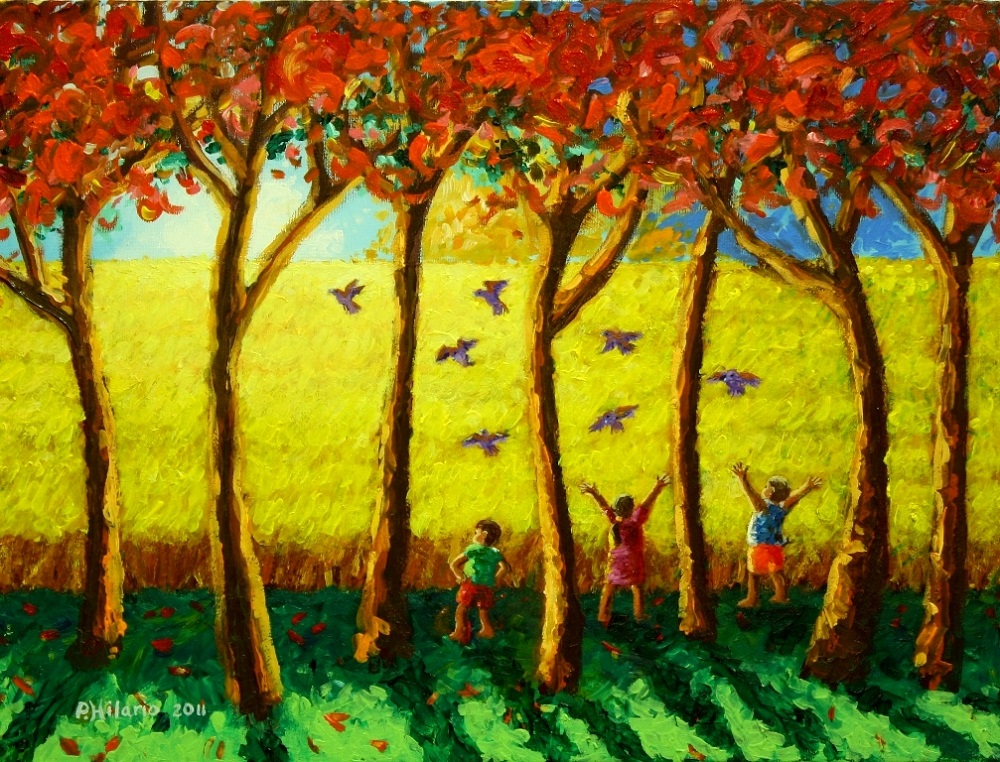
Outside my wall-to-wall office windows are a spectacular view of distant mountains and a picturesque stretch of the IRRI experimental rice fields. Sometimes, when I needed to relax from work, I would grab a cup of coffee and look out my windows. I find the scenery instantaneously calming.
I read rice-related news daily since my boss, Duncan Macintosh, an Australian, would send us, his staff, links to all pertinent rice-related news from around the world. I worked under the Visitors and Information Office so I had to be updated and knowledgeable on anything rice as I gave guests a tour of the museum almost daily.
So you can only imagine how I ended up making RICE as my first inspiration to paint.
But even before working at IRRI, I was already playing near and in rice fields in Asingan, Pangasinan. My paternal grandfather, Dionisio Hilario, or Papang as we called him, was a rice farmer. In my youth, I would spend my vacation on his farm and tend to his farm animals every summer.

I would feed the chickens, pigs, and cows. But one of my most enjoyable activities was riding his water buffalo. I remember riding it with only a thin plastic rice sack as a saddle. It was a hard ride, but as a kid, I didn’t care. I would also take his water buffalo to the nearby river to bathe it
I helped plant vegetables but I never did have the chance to plough the field and harvest rice. It was only at IRRI when I did that when I embarked on a week-long rice production training course.
My maternal grandfather, Gabriel Reynoso, on the other hand, was an artist. He was an expert in various types of art media. The portraits that he made reminded me of classical Renaissance paintings.
My uncle and godfather, Manny Reynoso, one of the sons of my Lolo Gabriel, once shared with me that a gallery owner he knew told him my Lolo Gabriel would have easily been accepted in fine art galleries, there were only a handful back in then, had he chosen to do so.
Lolo Gabriel had 12 sons and daughters to support so he had to choose a more commercial artistic career path where the income was more dependable and stable.
I guess my work is the synthesis of both my grandfathers. Rice plus art. I was born to be a rice artist.
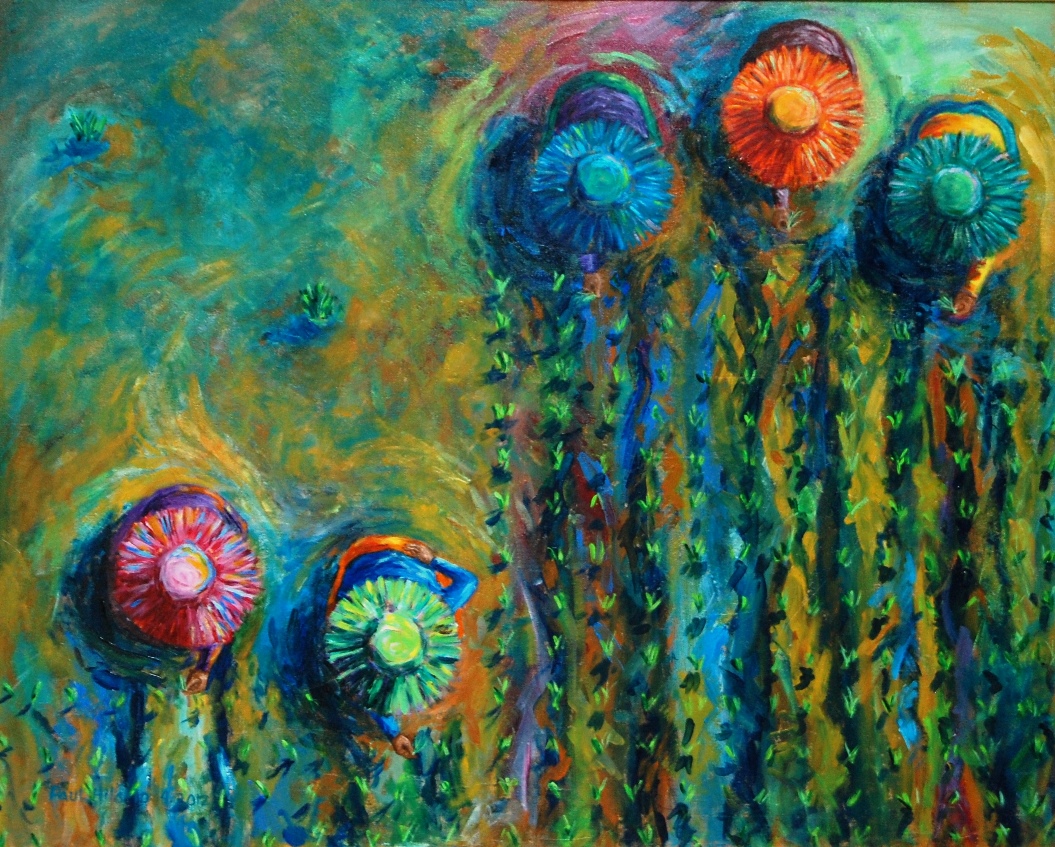
My first painting influence was Vincent Van Gogh. I said “painting” and not “art” because it was television, Marvel, and DC comics that got me started drawing when I was a kid.
I just love Van Gogh’s textures, colors, and the emotion that exudes from his works. I was taking up my Bachelor’s in Microbiology at the University of the Philippines Los Banos (UPLB) and it was during an art appreciation class where I first saw his works in more detail. Because I admired his works so much, naturally I wanted to paint like him.
I was already working at IRRI for almost eight years before I thought of doing fine art again. My wife, Dr. Maria Celeste Banaticla-Hilario, a botanist, was the trigger. She gave me a pasalubong—a gift of painting materials—from the Netherlands where she studied for three months. My wife was at that time the resident wild rice taxonomist of the International Rice Genebank at IRRI. Yes, we worked together.
One important insight that I would like to share is that rice-themed paintings usually display positive messages. The rice fields signify abundance, blessings, serenity, happiness, and hope. Rice farmers represent family, perseverance, teamwork, camaraderie, and patience. There are many more things it symbolizes depending on the viewer.
On the other hand, rice farming also signifies poverty and back-breaking work. Many rice farmers and laborers are dirt poor. It is ironic.
It is this irony that I keep in mind as I paint rice. I use a lot of colors–most of the time too colorful. But that is how I like it. I show the beauty and the hardship. The colors may mask the irony but for me, with my background, it is vivid and real. My works are a visual irony.

One of my favorite comments I have ever received about my work was from a fellow artist and curator, Irma Lacorte. She used to be the curator of the Sining Makiling Gallery at UPLB.
One time, she intoned, that someone was looking to purchase a rice painting.
“If you want a rice painting that has significance, get one from Paul Hilario,” Irma said.
Thank you, Irma.
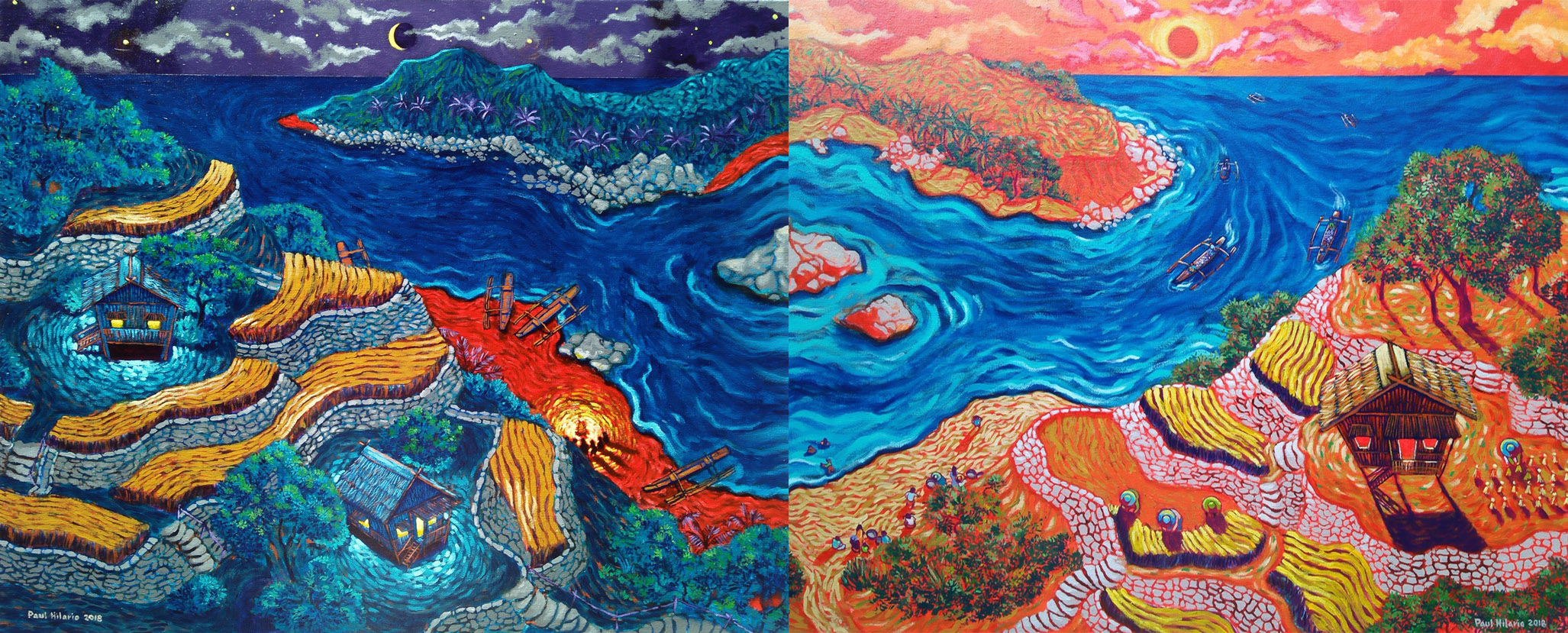
Why is this meaningful for me? Unfortunately in the Philippines, there is a general notion today that if you make traditional rice–themed artwork, you are a commercial painter. You are not a serious artist. You are only making rice as your theme to easily sell your artwork.
That may be true in some cases; however, my case may be a little bit different. I was just simply and truly inspired and enamored with rice as a subject.
It’s embedded in my spirit and I still enjoy doing it. IT’S IN MY ROOTS. RICE IS MY HERITAGE.
Many National Artists like Fernando Amorsolo, Vicente Manansala, Botong Francisco, and Ang Kiukok have used rice in their masterpieces, too. I am not comparing my work to them of course. They are legends. Metaphorically speaking, their roots are as expansive and as deep as that of the Narra tree. Mine are that of a rice plant.
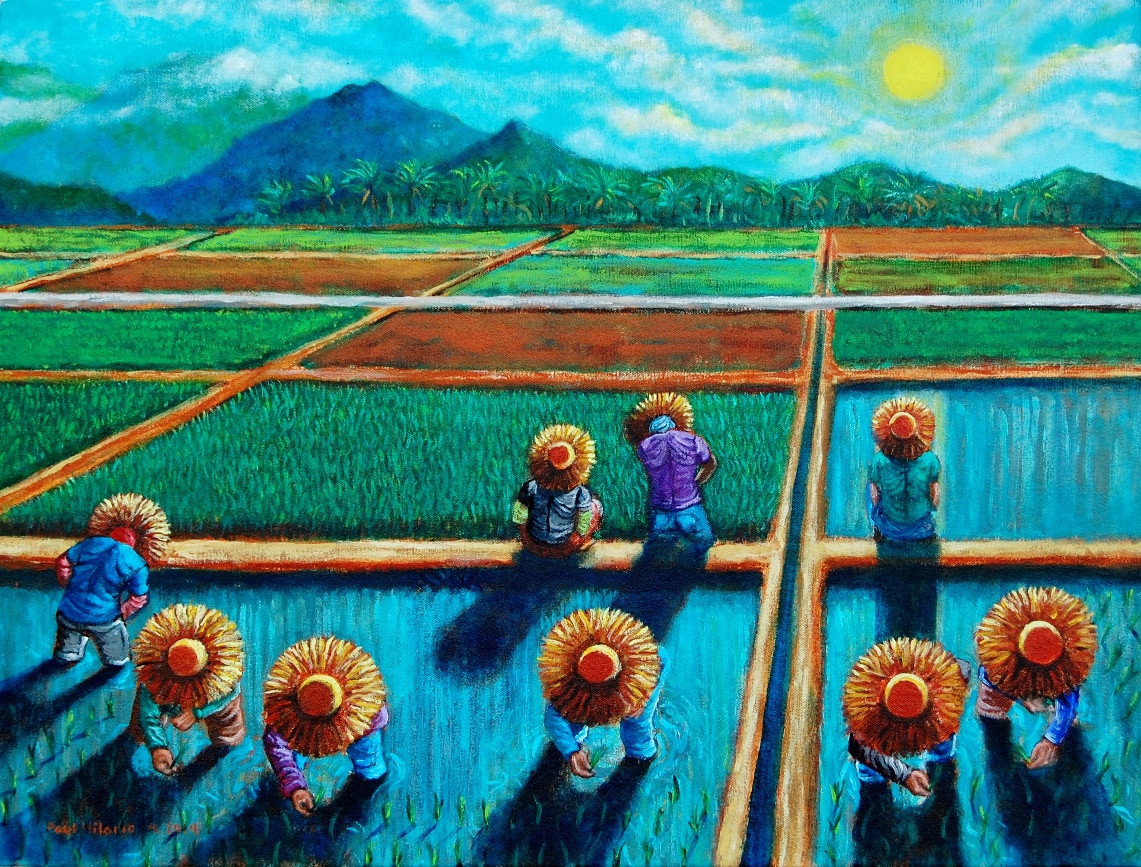
Although I do a lot of rice paintings, these are not the only ones I make. I also do visual narratives but with a technique inspired by another artist. I have recently worked on installation and sculptural pieces, too.
I kept painting as a part-time (with a full-time passion) activity from 2011 to 2017. I only slept about five hours a day during those times. I was able to do three solo shows in reputable galleries and quite a handful of group shows, three of them abroad.
In 2017, I left IRRI to be a full-time professional artist. It took me almost four decades before I found out where my heart truly belongs. I was a little bit late in my art career but that doesn’t matter. I’m here now for the long haul. They say artists never retire.
In this online exhibition, I share some sensibly selected rice artworks, most of which are no longer with me. Twenty-two pieces are new.
View the exhibit:
Return to Roots: A recollection of the past, a revelation of the present





